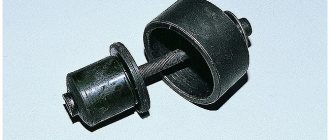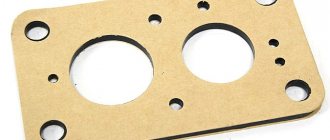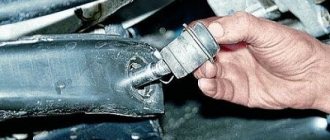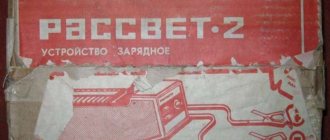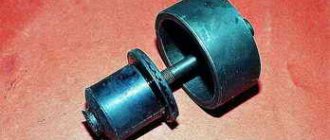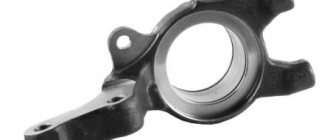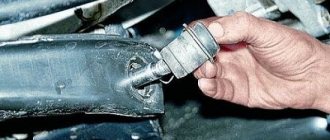Maintenance and timely repair of the vehicle chassis is the key to safety on the road. The maneuverability, trajectory, and controllability of the vehicle depend on the serviceability of many components and assemblies of the suspension. And not the last role is played by the silent block. This link should be examined first when certain symptoms appear that should not be present.
Why do you need a silent block?
The silent block is otherwise called a rubber-metal hinge. Externally, the part resembles a cylinder and consists of three main components:
- The outer part - steel is used for its manufacture; it also has seating elements: stiffeners and a shell.
- The core is a solid metal sleeve.
- Clearance - this space between two metal elements is filled with an elastic material (rubber or polyurethane).
The operation of the silent block is as follows. The inner sleeve is clamped on all sides by elastic material, which prevents its rotation. The outer bushing is in the same conditions and does not rotate relative to the rubber or polyurethane insert.
However, when a torsional force of a certain intensity occurs, the bushings can rotate relative to each other at a small angle, due to the elasticity of the filler. This limits the turning radius of the lever, but for the full functioning of the suspension this radius is quite enough. This rubber-metal part can also be called a dry hinge, since it performs its duties without lubrication. Its operation is ensured precisely due to the elasticity of the insert between the metal bushings.
In other words, the task of silent blocks comes down to dampening vibrations that inevitably arise when the car is moving. In addition, they prevent their spread between suspension units.
The car suspension on each side is connected to the body at 2 or 3 points. In the first case, it is attached to the lever and the strut, and in the second - to two levers and a shock absorber. That is, the number of parts depends on how many mounting points exist in the vehicle. It is these parts that bear the heaviest load.
What does it consist of
It consists of two bushings with a rubber insert between them. There are collapsible and non-collapsible. Those that can be disassembled are called rubber bushings, those that cannot be disassembled are called silent blocks.
The method of pressing bushings into rubber also varies. You can vulcanize it and the hinge will be rigid, this is reflected in its mobility and the smoothness of the suspension. If you glue it, the knot will be too elastic. The lever will have excessive mobility, which will affect the controllability and stability of the car. Therefore, two methods of installing a rubber layer are combined.
In addition, the rubber itself can be solid or pieces cut into it . This is how the manufacturer achieves the necessary elasticity of the rubber insert and the necessary mobility of the lever in certain planes. Because of this, the direction of movement arrow is indicated on the hinge; it must coincide with the arrow on the lever. This means that the silent block is pressed in correctly.
How to check the wear of the silent block and when it needs to be changed
Silent blocks, despite their small dimensions, are a reliable suspension consumable. Depending on driving style and the condition of the road surface in any particular area, parts of levers and torque rods can last up to 150 thousand km. Silent blocks of shock absorbers, struts, and anti-roll bar have a shorter service life - up to 50 thousand km.
In difficult operating conditions of vehicles (the Far North), with poor quality roads or regular off-road driving, diagnostics will have to be carried out twice as often. In addition, Russian realities are far from perfect, as every driver is well aware of.
How to understand that such a part has worn out and requires timely replacement? This will be indicated by characteristic signs. Drivers should listen to their own feelings and if the silent block malfunctions, they may feel a deterioration in the car’s controllability, the steering wheel begins to turn with a noticeable delay. All of this clearly points to a problem with this part.
To verify this, a visual inspection of the rubber-metal hinges is necessary, for which an inspection hole is needed. As for symptoms, in addition to those listed above, they may include the following:
- A quiet thud when driving over small bumps.
- A dull thump that comes from one side when making a sharp turn. This indicates a problem with the stabilizer joint.
- On a flat section of the road, the vehicle begins to deviate from a straight course. There is also side wear on the tires.
- Cracks in the intermediate filler, misalignment of the lever - this can be seen during a visual inspection of the suspension components.
You can entrust the diagnostics of the chassis to specialists by visiting the nearest service station. But if you have an inspection ditch in your garage, you can do this work yourself. After driving the car into a pit, you should inspect each hinge. If cracks or tears are found on the elastic filler, the verdict is clear - replacement is required.
However, this may not be the case, then to be sure, it is worth checking the performance of the silent blocks. To do this, use a pry bar to swing the suspension units with moderate force. If at the same time the lever makes significant vibrations or knocking can be heard, then the diagnosis is also correct - the silent blocks need to be replaced.
Just keep in mind that these parts are always replaced in pairs, even if the hinge is faulty on only one side of the suspension.
Advantages and disadvantages
The main advantages arise from the purpose of rubber-metal hinges:
- maximum quiet and comfortable operation of the unit;
- no maintenance requirements;
- there is no need to use lubricant, which deteriorates and develops over time;
- simplicity and low cost of design;
- diagnostic clarity that does not require qualified personnel;
- easy replacement at the end of its service life;
- the ability to set properties by selecting the material of the elastic element.
RMS competitors include all kinds of ball and cylindrical joints, which do not have the disadvantages inherent in silent blocks:
- Excessive freedom of movement in the hinge, characteristic of the RMS, is not always useful;
- cheap materials quickly age and deteriorate;
- rubber bushings do not work well at too high and low temperatures;
- strength under load is strongly related to the rigidity of the unit, and attempts to implement a compromise lead to an increase in weight, dimensions and cost;
- operating angles and the ability for relative movement of the clips over a wide range are limited.
On cars where control accuracy is more important than comfort and low price of the suspension, RMS have limited use. They are often replaced with ball joints (BJ) during sports car tuning.
Which silent block to choose?
Many drivers during the operation of their car are faced with the need to replace silent blocks, which cannot be avoided. Just as there is no perpetual motion machine, there are no parts with an infinite resource. And since the elastic filler is subjected to a large load of compression and straightening, the durability of the silent block depends on a number of factors:
- First of all, this is the quality of the material itself (rubber or polyurethane). Rubber elements give the suspension more softness, while polyurethane products have high wear resistance.
- Much also depends on the reliability of gluing the intermediate insert to the metal bushings. After all, if the integrity of the unit is violated, then its shock-absorbing properties are lost.
- Most car enthusiasts pay attention to the brand of rubber-metal joints and their cost. Moreover, each manufacturer makes its own recommendations regarding the use of parts from certain companies that have been tested and approved. However, it is not always possible to find original spare parts on sale, so drivers opt for silent blocks from other manufacturers. There are many products sold on the automotive market from a variety of companies, but not every product is highly efficient in difficult Russian road conditions.
Recently, polyurethane products have become widespread. But is such a purchase justified or is it still better to give preference to the usual silent blocks with rubber filling?!
What happens if the silent blocks are not changed on time?
When the part wears out, a gradually increasing play appears (in the block seat). As a result, the sleeve hole is also developed. This is fraught with:
- pulling the car to the side at high speed;
- increased and uneven tire wear;
- poor handling, especially noticeable when cornering;
- the appearance of a feeling of discomfort when moving, because hitting even small obstacles will bring unpleasant sensations.
How to remove the silent block
Selecting the right hinge is half the battle; you should replace it. To do this, you can visit a service station, but since the operation is not so complicated, you can do the work yourself. But first you need to remove the worn part and for this you do not need to have a special tool; it will be needed at the stage of installing the silent block.
Pressing out can be done using improvised means. To do this, first cut off the protruding rubber filler on one side, and then knock it out with a hammer using a metal attachment.
The silent block can be removed from the lever using another method. Take a bolt onto which a washer of smaller diameter than the eye of the lever is put. Then the bolt is inserted into the bushing of the worn part, a piece of pipe with a washer is placed on the other side (its diameter must correspond to the size of the pipe) and the nut is screwed on. Then, using one wrench, the bolt itself is held in place, and the nut is screwed in with the other. At the same time, it will begin to push the silent block out of the eye into a piece of pipe.
For some products, another method is suitable - soldering with an open fire. But it is better not to use it, since prolonged exposure to high temperatures can only cause harm, negatively affecting the structure of the metal. Over time, it will begin to quickly lose its properties, and the suspension unit will become unusable. In this regard, only the mechanical method should be used.
Preparing to replace silent blocks: necessary tools
What you need, what tools and materials to replace silent blocks:
- New set of silent blocks.
- Any lubricant (in the form of cream or spray).
- A hammer with a chisel or a special puller. By the way, we looked at how to make a silent block remover with your own hands. If anyone is interested, watch and do it.
- Sandpaper.
- Vise.
- Sponge.
- Water.
- Set of keys: socket and open-end.
- Jack.
- Lift, pit or overpass.
- Protective glasses.
- Gloves.
For convenience, before starting work, you need to remove dirt and wash the parts being replaced.
How to install a new silent block
Required Tools
Now you can’t do without special “equipment”. The fact is that such a part fits very tightly in its seat, and it will not be possible to hammer it in with a hammer. Therefore, the very first tool you need is a puller. You can buy it at any relevant store or make it yourself. To do this, you should find the following “ingredients” in your garage:
- M20 bolt (the longer the better) with a full-length thread and a nut.
- Metal washers of various diameters.
- A piece of pipe with thick walls (100 mm), its diameter will depend on the size of the lever eye.
You will also need other tools:
- keys (even a whole set);
- new parts;
- jack, vice (if any will be useful);
- mount.
You may also need a sledgehammer, and more than one, but you should use them carefully, maintaining precision.
Replacement process
If the silent block of the lever is to be replaced, then it will not be possible to perform the work without removing it. It is necessary to first dismantle the unit and only then begin the replacement process.
The first step is to remove the worn part from the lever. How this can be done was written above. Now you need to press in a new silent block. For this purpose, you can use the same technique that was described above to remove the silent block using a bolt, washer, nut and pipe.
Almost every garage has a vice, and this is also suitable “equipment” for removing and pressing silent blocks using spacers.
Whatever method of “packaging” the silent block is chosen, before installing a new part, the seat should be cleaned of rust and remnants of a worn part. After this, the “socket” must be lubricated with soapy water to facilitate installation. It is undesirable to use oil, grease and other petroleum products for this purpose, especially in relation to products with rubber filling. You can also make a small chamfer on the end part of the silent block on the rubber. The main thing is not to cut off too much.
Necessary materials
To press this part into place at home, you will need the following tools:
- Mount;
- Jack;
- Set of wrenches;
- New hinges.
It is recommended to use machine oil or other types of lubricant as a lubricant.
Among other things, you will need special mandrels designed for pressing silent blocks; as an alternative, you can use a piece of pipe with the required diameter. You also need to get a press to press in a new rubber-metal hinge . When it comes to home use, an ordinary vice can serve as a press. In addition, you can stock up on a set of sledgehammers, but with this approach it is necessary to maintain high precision in the work.
Bottom line
In no case should you ignore any extraneous sounds, otherwise everything may end in an unfavorable outcome - expensive repairs. Faulty silent blocks lead to increased load on the suspension components. And this in turn affects ride comfort.
You should purchase original parts, cheap Chinese fakes, although they do not require large investments, break at the most inopportune moment, and then what kind of savings can we talk about?! Only with serviceable and original parts can you experience full comfort from driving your car.
